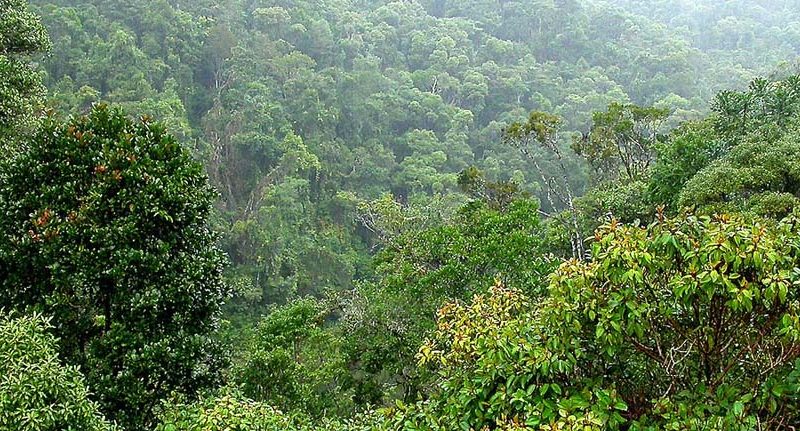80% of the Malagasy vegetation is endemic: Madagascar has one of the richest flora in the world, divided into different environments or ecosystems, almost unique in the world. From North to South, from East to West, find a glimpse of the Malagasy vegetation.
On the east coast, the dense humid forest:
Facing the Indian Ocean, the east coast of Madagascar enjoys high rainfall, the source of 6 million hectares of tropical rainforest. It stretches along the coast, in a long narrow strip, at low altitude – below 800 meters.Trees that grow in tight rows can reach 30 meters in height. They are said to be “persistent”: they keep their foliage and stay green all year round. Dalbergia, Uacapa, Symphonia … the tallest species form a high canopy, they capture as much light as possible, leaving only a fairly dark area under the foliage. In the lower floors of the forest, we then find the famous Pandanus, palm trees, and especially many species of orchids. For both its fauna and its flora, this ecosystem is considered to be one of the richest in biodiversity on the planet: while it represents only 7% of the earth’s surface, the dense humid forest alone contains 70% of the species known to the planet, 80% endemic. Madagascar’s dense humid forest is one of the most threatened forests in the world. Only a third of the primary forest remains. To protect its unique ecosystems and their biodiversity, as well as to educate visitors, many protected areas have been created. Eastern Madagascar has many national parks, known for their natural wealth, and many of them are listed as a UNESCO World Heritage Site. One of the best examples is Ranomafana National Park
On the west coast, the dry tropical forest and the mangrove:
Madagascar’s tropical dry forest stretches over 2,580,000 ha west of Red Island, on the coast, up to about 800 meters above sea level. Much more sparse than in the western forests, the trees seem to spring up from the savannah. They are mainly baobabs, tamarind trees, palm trees. In the thickets sometimes hide a few land turtles. Like the dense humid forest, it is a particularly threatened ecosystem, victim of fires and intensive agriculture. Kirindy Mitea National Park is a fine example of dry forest, such as Tsingy de Bemaraha National Park, known for its “forest” of tsingys. On the western coast, at the water’s edge, is the mangrove, which is also one of the most bioverically rich ecosystems on the planet. It covers approximately 300,000 ha. The mangroves and mango trees are the most representative species, they fly over the water thanks to a tight network of roots. It is home to many aquatic species: by protecting currents and large predators, rich in sediment and algae, the mangrove is a real nursery. It is also the habitat of sea birds, reptiles, molluscs, amphibians … Particularly adapted to a rather harsh environment, mangrove plants remain fragile and threatened by increasingly common cyclones and storms.
In the heart of the country, savannah and bush:
The heart of Madagascar is that of the great outdoors, in the grassy savannah. The tall grasses are punctuated with tall baobabs, and a few thorns. Unlike other Malagasy ecosystems, the place is not considered to be the richest in biodiversity, but the ocher-colored landscapes remain spectacular. At the southern end of the island, a bush is concentrated: it feels like Australia, and yet 80% of the species are found nowhere else on the planet. Over 3,000,000 ha, there is a short forest of thorny shrubs and thickets, the main species of which are euphorbia, didiereceae and apocianaceae. Particularly adapted to arid soils, the vegetation develops as close to the ground as possible, developing its means of storing water and saving as much as possible: rhizomes, varnished, waxed leaves … such as aloes and agaves, thick, flowery leaves full of nectar. The road from Beloha to Ambovombe crosses the Androy through the bush. From the side of the road we can see the prickly pears, and the king’s hedges, which gave their name to the region: with its thorns, the bush is a real rampart. The bush is also the fertile ground for zebus, and near towns, sisal, made from an agave plant, is grown to make ropes and rugs.
SOURCE: https://lemag.corsair.fr/2018/02/08/vegetation-typique-de-madagascar/
HT AGENCY TOURS
Luxury Madagascar with the best luxury African safari tours packages. Discover your next perfect destination with HT Agency Tours

